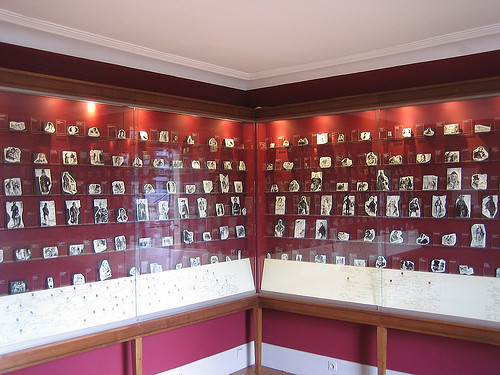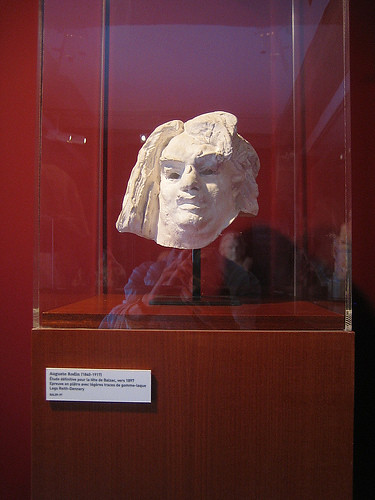In 2008, when I returned to Paris, I made my way to his former residence, La maison de Balzac, in the western edge of the city, near Musée Marmottan Monet and Jardins du Ranelag in its vicinity. Balzac rented the top floor of that rather modest house, from 1840-1847 under his housekeeper's name (Mr. de Breugnol), evading his creditors from the city.
I loved Balzac's keen and cutting observation of the colorful characters populated the brutal society in Paris and provinces, and was delighted to see a roomful print blocks of main characters from his enormous, though unfortunately unfinished, La Comédie humaine. Amongst those characters, my favorite had always been Eugène de Rastignac, a charming and innocent lad from province to a roguish and cynic though not without redeeming qualities, featured in several of his novels in this series.

Print blocks of characters from La Comédie humaine by Honoré Balzac
In the block below, Rastignac, after having buried the self-sacrificing Père Goriot, swore to fight with the corrupted city and its high society, before he jumped into the battle headlong, by joining his mistress, the younger daughter of Père Goriot, Delphine, Baroness de Nucingen. It was the moment of truth and resolution, a moment of leaping from innocence to corruption. The image was an utterly bleak and most biting assessment of the glittering Paris and its dazzling society.

Eugène de Rastignac dans le cimetière du Père-Lachaise dans Le Père Goriot
My second favorite artwork there was a definitive study of a head sculpture of the novelist by Auguste Rodin, made around 1897 - Étude définitive pour la tête de Balzac. Behind exuberant air of the novelist, Rodin captured his sharp gaze and presented him as simultaneously sagely and clownish, embodying the broad spectrum of his oeuvre and his epoch.

Étude définitive pour la tête de Balzac, vers 1897, Auguste Rondin
My Favorite Museum Collection Series
>> My Favorite Museum Collection Series 72: My Favorite Artworks at Maison de Victor Hugo, Paris
<< My Favorite Museum Collection Series 70: My Favorite Sculptures in Jardins du Ranelag, Paris
>> My Favorite Museum Collection Series 72: My Favorite Artworks at Maison de Victor Hugo, Paris
<< My Favorite Museum Collection Series 70: My Favorite Sculptures in Jardins du Ranelag, Paris
Other Related posts on Art · 文化 · Kunst:
- My Favorite Paintings at Musée Marmottan Monet
- My Favorite Sculptures at Musée Rodin, Paris
- Revisiting Norton Simon Museum in Pasadena
- My Favorite Paintings from Musée Picasso, Paris
- The Museum of Modern Art, New York City
- My Favorite Sculptures at Cimetière du Père-Lachaise, Paris
- Fifteen Authors Influenced Me Most and Watching Shakespeare in China
- Swiss Author and Dramatist Friedrich Dürrenmatt
- Molotov's Magic Lantern: A Journey In Russian Histoy by Rachel Polonsky and Some Journeys of My Own
- Review of "As Above, So Below" by Rudy Von B. Rucker





No comments:
Post a Comment